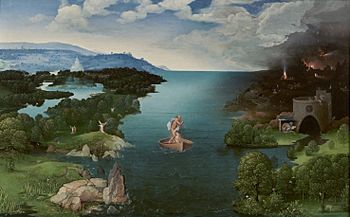Landscape with Charon Crossing the Styx facts for kids
Quick facts for kids Landscape with Charon Crossing the Styx |
|
|---|---|
 |
|
| Artist | Joachim Patinir |
| Year | c. 1515–1524 |
| Medium | Oil on wood |
| Dimensions | 64 cm × 103 cm (25 in × 41 in) |
| Location | Museo del Prado, Madrid |
Landscape with Charon Crossing the Styx is a famous painting by Joachim Patinir. He was an artist from the Northern Renaissance period. This painting was made around 1515 to 1524. Today, you can see it at the Museo del Prado in Madrid, Spain.
Patinir's art, like this painting, shows new ideas from the 16th century. Artists in places like Germany and the Netherlands started mixing their old traditions with new styles. Many, including Patinir, traveled to Italy. They learned new ways to paint nature. Patinir's religious paintings often show amazing landscapes. These landscapes combine real-life details with fantastic scenes.
What the Painting Shows
This painting tells a story from ancient myths and Christian beliefs. It shows a scene from the Aeneid by Virgil and Inferno by Dante. At the center, you see a large figure in a boat. This is Charon, who carries the souls of the dead. He takes them to the gates of Hades, the underworld.
The small person in the boat is a human soul. This soul must choose its path. To the right (your left) is Heaven. To the left (your right) is Hell. The Styx river divides the painting in half. This river is one of the four rivers of the underworld. It flows through the deepest parts of hell.
On the painting's left side, you see the fountain of Paradise. This is a beautiful spring. From it, the river Lethe flows through Heaven. It looks bright and peaceful.
On the right side, Patinir shows his idea of Hell. He was inspired by the artist Bosch. In front of Hell's gates is Cerberus. This is a scary three-headed dog. He guards the entrance and frightens any souls trying to enter Hades. The soul in the boat seems to choose Hell. It looks towards the dark side. It ignores the angel in Paradise that calls it to Heaven.
Colors and How It's Made
Patinir used a special way to compose this painting. It's called a Weltlandschaft, or "world landscape." This means it looks like you are seeing a huge area from high above. He also used a three-color plan. This was common in his work. The colors go from brown in the front, to bluish-green in the middle, and then to pale blue in the back.
The painting uses colors to show good and evil. The left side, representing Heaven, has bright blue skies. The rivers are crystal clear. There is a glowing fountain and angels on grassy hills. It looks very inviting.
On the far right, Hell is dark. The sky is gloomy. Fires burn on the hills. The front part of the painting shows brown rocks in Heaven. In Hell, you see burnt brown trees.
In the middle of the painting, the river and grasslands are bright. They are painted in shades of blue and green. The background is a pale blue sky. It has white and gray clouds. This way of painting guides your eye. The crowded sides push your view to the open middle. This makes sure you focus on the people in the boat. They are the most important part of the painting.
See also
 In Spanish: El paso de la laguna Estigia para niños
In Spanish: El paso de la laguna Estigia para niños

